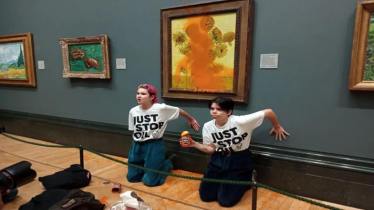The world felt for the climate when Greta Thunberg addressed the 2019 UN Climate Action Summit. Her choice of words worked like a dagger into many hearts and soon a lot of political leaders responded to her speech and took notice of the climate crisis. However, the increasing number of incidents of defacing famous artworks to draw attention to the climate has enraged art lovers and environmentalists across nations.
As Europe faces the worst of droughts and wildfires that are badly impacting its economy, climate activists are choosing every way possible to better communicate the severity of the climate crisis and the need to end the use of fossil fuel that causes it.
Moving ahead from street protests and coal power blockades, two activists from the ‘Stop Oil’ organisation threw tomato soup at Van Gogh’s famous “Sunflowers” at the National Gallery in London. French Impressionist Claude Monet’s “Grainstacks” painting in Barberini Museum in the German city of Potsdam was also spoiled with mashed potatoes by German activists called the ‘Letzte Generation’, meaning Last generation.
According to Aimee von Baalen, the spokesperson for Last Generation, the attack on Claude Monet’s painting was an act of vandalism that shows how little people care about the world’s destruction. She also stated that Monet was an art lover and the artist captured the essence of nature in his paintings, which the activists want to protect. “There will be no time for admiring art if we fight each other over food and water!” Baalen said, reported IE.
The incident has caused a lot of outrage in the art world. Hasso Plattner, the founder of the Museum Barberini, stated that it would be difficult to find a lender for future exhibitions if such acts continue to threaten the art community, as per IE’s report.
Several museums in the city of Cologne have also condemned the vandalism and are planning on addressing the issue with special attention. A spokesperson for the city said that the museums have been warned about the attacks. The museums are ramping up security measures to avoid such acts of vandalism.
Also Read: British PM Rishi Sunak’s connection with Infosys becomes meme fest
But this is not the first time art was exploited to make a political statement. According to IE, in 1914, a portrait of philosopher Thomas Carlyle was vandalised by a British suffragette. In 1995, Chinese artist Ai Weiwei destroyed a 2,000-year-old cultural symbol to make his controversial work, “Dropping a Han Dynasty Urn,” and it remains one of his most famous works.
Simon Bramwell, a co-founder of Extinction Rebellion pointed out that it is high time that the art world should join the climate movement. Several prominent institutions, such as the Van Gogh Museum and the Tate gallery, have already refused support from fossil fuel companies.
